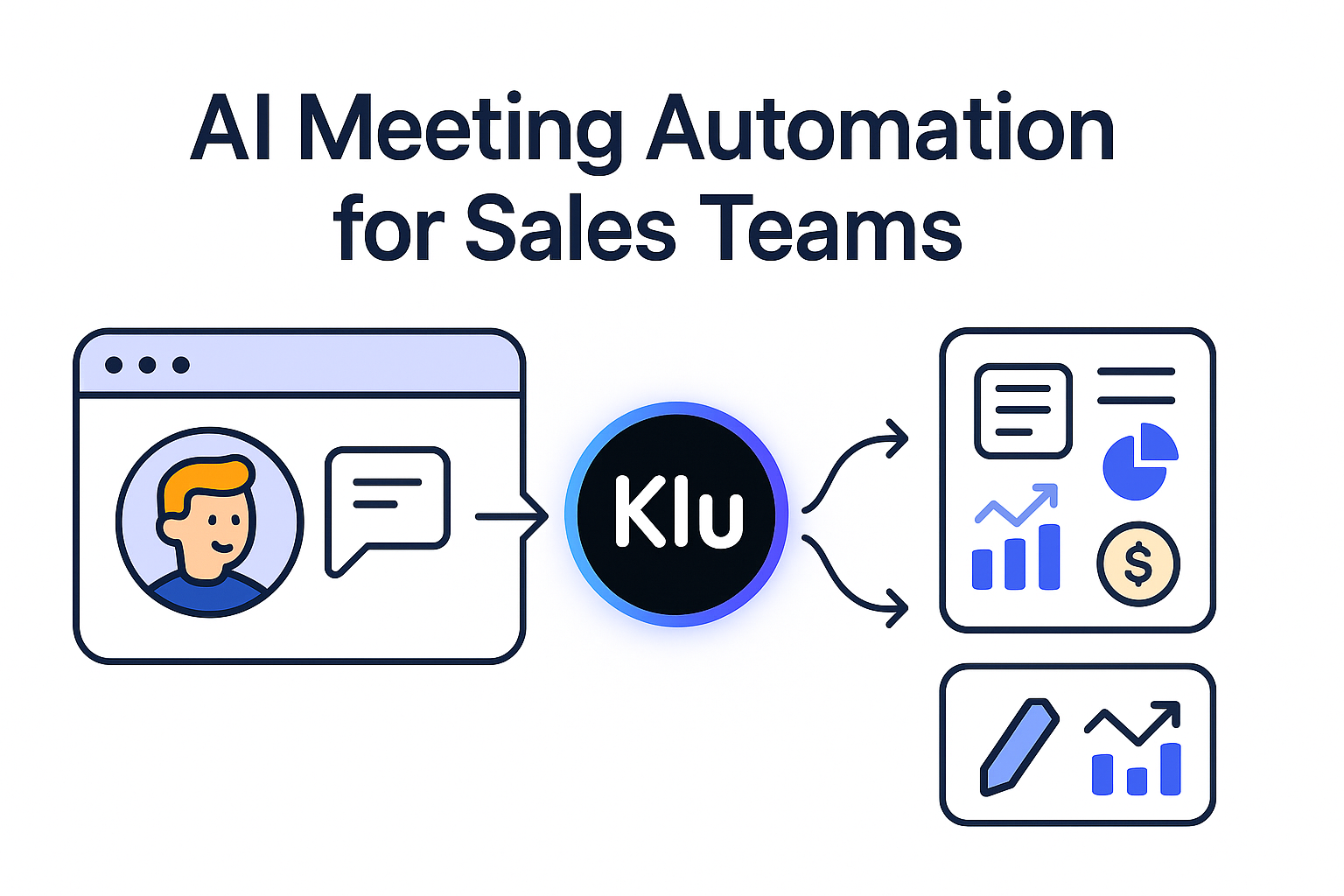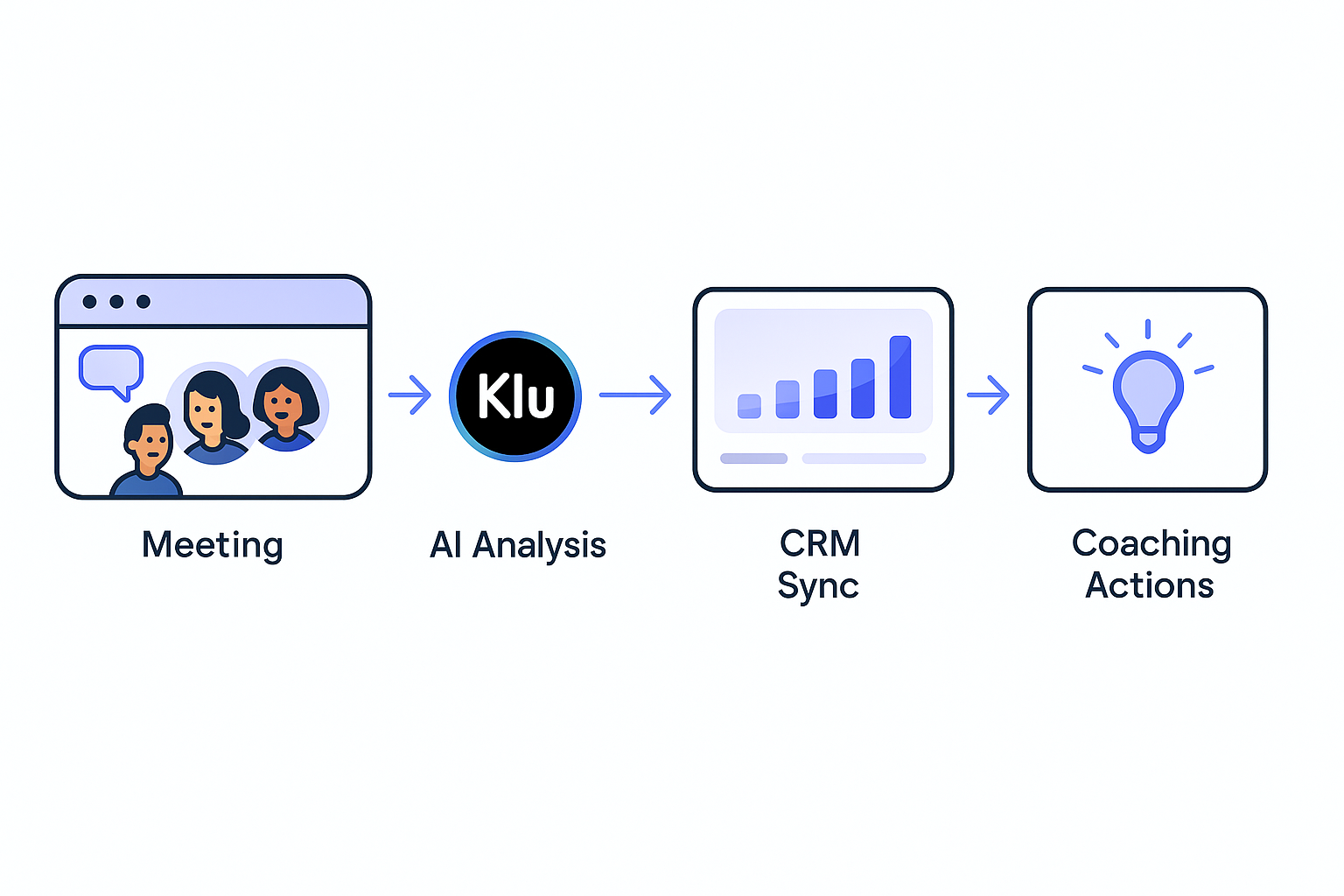 Sami AZ
Sami AZ
In 2025, B2B sales teams face a unique challenge. Meetings have increased in both number and complexity, yet the real value that emerges from those meetings often does not translate into coordinated action, reliable pipeline forecasts or efficient follow-up. Research from McKinsey & Company shows that while 92 % of companies plan to increase AI investments over the next three years, only 1 % consider themselves fully mature in embedding AI into workflows. At the same time, the global market for AI meeting assistants is projected to expand from USD 3.67 billion in 2024 to USD 72 billion by 2034 — a compound annual growth rate (CAGR) of 34.7 %.
What does that mean for sales teams? It means the moment is now to shift from simply “using meetings” to leveraging “meeting automation” as a strategic growth lever. And that is where meeting automation is no longer a nice-to-have but a must-have for modern revenue teams.
In this article you will learn:
By the end you will see not only why you should adopt meeting automation but also how to execute it effectively.
Sales teams, especially in hybrid or remote environments, spend a growing share of their time in meetings. Yet many of those meetings produce little measurable follow-through. One study indicates that productivity gains from AI become fully realised only when AI is embedded into workflows rather than used as a point tool.
For example, when reps are still manually taking notes, creating tasks and then entering data into the CRM, they lose hours each week on administrative work instead of selling. That lost time erodes potential revenue. With meeting volumes high, the only way to regain that time is via automation.
The numbers tell the story:
These data points underscore that meeting automation is not an experimental luxury but a revenue driver in a fast-evolving market.
Standard meeting platforms provide scheduling, video, and perhaps transcription. But they leave the heavy lifting to your reps and managers: capturing decisions, extracting key action items, analysing sentiment, submitting data into the CRM, then surfacing insights for coaching or forecasting. That gap is where the real value exists.
Meeting automation closes the loop: capture → insight → action. It allows sales leaders to move from “What happened in my meetings?” to “What will happen in my pipeline?” That shift is critical in 2025 if you want to outperform peers.
An effective meeting automation system must automatically detect, record and upload meeting audio/video. The manual intervention of a rep starting the recording or turning it in is still a friction point. Automating capture ensures full coverage.
Beyond transcription the system should:
These capabilities turn raw meeting transcripts into actionable insights.
Automation must connect to your workflow stack. For example: a meeting ends → identified action item → task created in your CRM or work tool (e.g., HubSpot, Pipedrive, Notion, Slack) → rep notified → due date tracked → manager dashboard updated. Without workflow integration, insights remain stuck in isolation.
True meeting automation surfaces signals ahead of time. For instance:
These insights allow sales leaders to coach proactively rather than react.
If you’re operating in Finland or globally you also need: multilingual support, data-residency/compliance (GDPR), enterprise admin controls, global integrations. Meeting automation must work across languages, platforms and regional data laws.

Once Klu is connected to meeting platforms (Google Meet, Microsoft Teams, Zoom) it detects scheduled meetings and automatically records them. This removes the need for manual rep action.
After capture, Klu transcribes and processes the meeting transcript using natural-language-processing and machine-learning to identify key moments: commitments, next-steps, objections, sentiment changes. Klu then creates structured summaries.
See how Klu integrates with Google Workspace, Microsoft Teams, Slack and Notion and others.
Klu pushes extracted insights into your CRM or work tools. Action items become tasks, commitments become deal-update triggers, follow-ups become automated reminders. This ensures your meeting data converts automatically into pipeline actions.
Klu’s analytics dashboard aggregates across meetings. Sales leaders can view: deal-health scores derived from meeting conversations, rep performance heat-maps, coaching flags. This turns meeting data into forecast intelligence.
Managers can use the insights to coach reps: see which objections pop up frequently, which reps fail to generate commitments, which deals show low meeting engagement. Reps receive automated feedback and next-step prompts based on data.
Rather than rolling out to 100 % of meeting volume, focus your pilot on high-value meeting types: close-deal calls, executive reviews, large-account pipeline reviews. This yields measurable results faster and builds internal champions.
If your team uses Google Workspace, Slack and HubSpot (common in Finnish scale-ups) ensure Klu is configured to auto-tag meetings, link CRM contacts, and create tasks in Slack channels or Notion databases. Tight alignment with your stack ensures adoption and data integration.
Operating in Finland / Espoo offers a few unique advantages:
Key metrics to monitor:
For example, many organisations in AI sales automation report forecast accuracy improvements of 20-30 %.
Once you have early wins and adoption, scale into other meeting types: discovery calls, internal strategy sessions, QBRs. Each new meeting type adds data and refines your insights.
Company X is a Helsinki-based SaaS vendor focused on mid-market enterprise customers. Prior to deploying Klu their sales team faced the following issues: inconsistent meeting notes, delayed CRM updates, poor visibility into deal health, and an average of 6 hours per rep per week spent on meeting administration.
The case study underscores how meeting automation can shift your revenue operation from lagging to predictive.
To quantify the impact of meeting automation with Klu, use the following rough metrics:
Sales teams using AI meeting automation with Klu typically save between three and six hours per rep each week, thanks to automatic note-taking, action tracking, and CRM updates. Forecast accuracy improves by approximately 20 to 30 percent, as insights from meetings flow directly into pipeline dashboards and deal reviews. Additionally, most teams report an increase of 15 to 25 percent in on-time task completion, since follow-ups are automatically created and assigned within their workflow tools.
Example calculation
If you have a 10-rep team and each rep saves 4 hours per week, at a loaded cost of €60/hour that equals:
4 hours × 10 reps × €60 = €2,400/week → ~€9,600/month or ~€115,000/year.
Add to that improved forecast accuracy (leading to fewer missed targets) and you have a compelling business case for meeting automation.
To maximise value from meeting automation you should ensure these components are in place:
When evaluating meeting automation tools you should ask the following:
If you answer yes to most of these, you are well positioned to adopt meeting automation as a strategic lever.
The trend is clear: AI is moving from “assistant” to “automation engine”. As noted by PwC in their 2025 predictions:
“Your AI strategy will put you ahead or make it hard to ever catch up.”
For sales teams this means meeting automation — once considered experimental, becomes central to revenue operations. Sales leaders who fail to embed meeting AI into workflows risk falling behind.
In 2026 and beyond, meeting automation will evolve further:
By adopting a platform like Klu now, you position your organisation to lead rather than respond.
Q: What is “AI meeting automation”?
A: It is the use of artificial intelligence to automate all aspects of a meeting workflow: capture, transcription, summarisation, action-item extraction, task creation, CRM update and insight generation.
Q: How does Klu differ from a simple transcript tool?
A: Klu goes beyond transcription by analysing the conversation for commitments, next-steps and sentiment changes. It then pushes structured insights into your CRM and workflows, turning meetings into actions rather than just records.
Q: Is meeting data secure and compliant for Finland / EU operation?
A: Yes. Klu supports enterprise grade security, multilingual support and data-residency compliant options. Be sure to review your contract and data processing addendum with Klu for your regional context.
Q: How quickly can we see results with meeting automation?
A: With a focused pilot on high-impact meeting types, you can start to see measurable hours saved and data-driven insights within 30-90 days.
Q: What if my sales team uses multiple meeting platforms (Zoom, Teams, Google Meet)?
A: Klu supports multi-platform meeting capture and centralises data into a unified dashboard. That ensures no meeting type is left behind.
Ready to turn every meeting into revenue-driving insight? Request a personalised demo of Klu today and see how your sales team can automate meetings, improve forecast accuracy and reclaim hours each week.